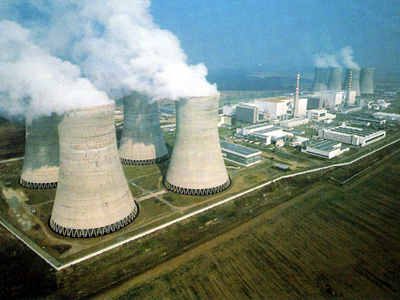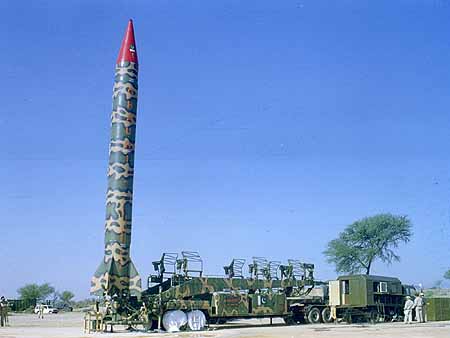Nuclear energy began to be developed in the 1940s by the United States to win World War II.
The use of nuclear energy based on Einstein equation (E = mc2), and was first developed by physicist Robert Oppenheimer as head of the atomic bomb project.
after years of the 1950s, nuclear energy is used for civilian purposes ie as a powerhouse.
This is because the efficiency of nuclear power plants (NPP) is quite high, especially with small mass ('fuel') to generate big energy.
5 countries asia nuclear users
-Its first commercial nuclear power reactor began operating in mid 1966, and nuclear energy has been a national strategic priority since 1973.
-The country's 54 reactors provide some 30% of the country's electricity and this is expected to increase to at least 40% by 2017.
-Japan has a full fuel cycle set-up, including enrichment and reprocessing of used fuel for recycle.
-Nuclear energy is a strategic priority for South Korea and capacity is planned to increase by 56% to 27.3 GWe by 2020, and then to 35 GWe by 2030.
-Today 21 reactors provide almost 40% of South Korea's electricity from 18.7 GWe of plant.
-Because India is outside the Nuclear Non-Proliferation Treaty due to its weapons program, it was for 34 years largely excluded from trade in nuclear plant or materials, which has hampered its development of civil nuclear energy until 2009.
-Due to these trade bans and lack of indigenous uranium, India has uniquely been developing a nuclear fuel cycle to exploit its reserves of thorium.
-Now, foreign technology and fuel are expected to boost India's nuclear power plans considerably. All plants will have high indigenous engineering content.
-India has a vision of becoming a world leader in nuclear technology due to its expertise in fast reactors and thorium fuel cycle.
-Additional reactors are planned, including some of the world's most advanced, to give more than a ten-fold increase in nuclear capacity to at least 80 GWe by 2020, 200 GWe by 2030, and 400 GWe by 2050.
-China is rapidly becoming self-sufficient in reactor design and construction, as well as other aspects of the fuel cycle.
-Because Pakistan is outside the Nuclear Non-Proliferation Treaty, due to its weapons program, it is largely excluded from trade in nuclear plant or materials, which hinders its development of civil nuclear energy.
The use of nuclear energy based on Einstein equation (E = mc2), and was first developed by physicist Robert Oppenheimer as head of the atomic bomb project.
after years of the 1950s, nuclear energy is used for civilian purposes ie as a powerhouse.
This is because the efficiency of nuclear power plants (NPP) is quite high, especially with small mass ('fuel') to generate big energy.
5 countries asia nuclear users
Nuclear Power in Japan
-Japan needs to import some 80% of its energy requirements.-Its first commercial nuclear power reactor began operating in mid 1966, and nuclear energy has been a national strategic priority since 1973.
-The country's 54 reactors provide some 30% of the country's electricity and this is expected to increase to at least 40% by 2017.
-Japan has a full fuel cycle set-up, including enrichment and reprocessing of used fuel for recycle.
Nuclear Power in South Korea
-South Korea is set to become a major world nuclear energy country, exporting technology. It won a $20 billion contract to supply four nuclear rectors to UAE. -Nuclear energy is a strategic priority for South Korea and capacity is planned to increase by 56% to 27.3 GWe by 2020, and then to 35 GWe by 2030.
-Today 21 reactors provide almost 40% of South Korea's electricity from 18.7 GWe of plant.
Nuclear Power in India
-India has a flourishing and largely indigenous nuclear power program and expects to have 20,000 MWe nuclear capacity on line by 2020 and 63,000 MWe by 2032. It aims to supply 25% of electricity from nuclear power by 2050.-Because India is outside the Nuclear Non-Proliferation Treaty due to its weapons program, it was for 34 years largely excluded from trade in nuclear plant or materials, which has hampered its development of civil nuclear energy until 2009.
-Due to these trade bans and lack of indigenous uranium, India has uniquely been developing a nuclear fuel cycle to exploit its reserves of thorium.
-Now, foreign technology and fuel are expected to boost India's nuclear power plans considerably. All plants will have high indigenous engineering content.
-India has a vision of becoming a world leader in nuclear technology due to its expertise in fast reactors and thorium fuel cycle.
Nuclear Power in China
-Mainland China has 13 nuclear power reactors in operation, more than 25 under construction, and more about to start construction soon. -Additional reactors are planned, including some of the world's most advanced, to give more than a ten-fold increase in nuclear capacity to at least 80 GWe by 2020, 200 GWe by 2030, and 400 GWe by 2050.
-China is rapidly becoming self-sufficient in reactor design and construction, as well as other aspects of the fuel cycle.
Nuclear Power in Pakistan
-Pakistan has a small nuclear power program, with 425 MWe capacity, but plans to increase this substantially. -Pakistan's nuclear weapons capabilities of has arisen independently of the civil nuclear fuel cycle, using indigenous uranium.-Because Pakistan is outside the Nuclear Non-Proliferation Treaty, due to its weapons program, it is largely excluded from trade in nuclear plant or materials, which hinders its development of civil nuclear energy.
Nuclear Power in Iran
-A large nuclear power plant is nearing completion in Iran. -The country also has a major program developing uranium enrichment, and this was concealed for many years.
-Iran has not suspended its enrichment-related activities, or its work on heavy water-related projects, as required by the UN Security Council.
-Iran produced 215 billion kWh gross in 2008 from over 31 GWe of plant, giving per capita consumption of about 2000 kWh/yr. 80% of its 2008 electricity was from gas and 16.5% from oil, both of which it has in abundance, and it get some from hydro when available.
-Iran produced 215 billion kWh gross in 2008 from over 31 GWe of plant, giving per capita consumption of about 2000 kWh/yr. 80% of its 2008 electricity was from gas and 16.5% from oil, both of which it has in abundance, and it get some from hydro when available.
Title: 5 countries asia nuclear users
Posted by:
Published :2011-04-04T15:44:00-07:00
5 countries asia nuclear users
Posted by:
Published :2011-04-04T15:44:00-07:00
5 countries asia nuclear users









No comments:
Post a Comment